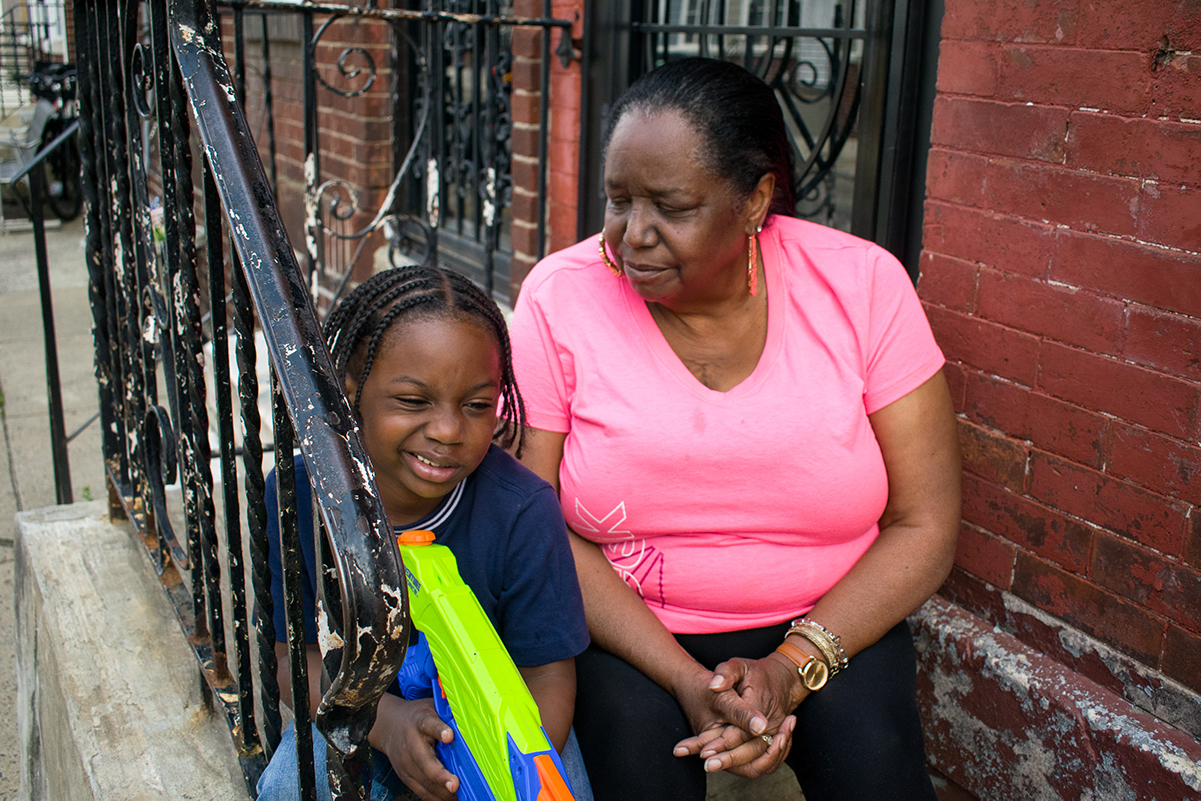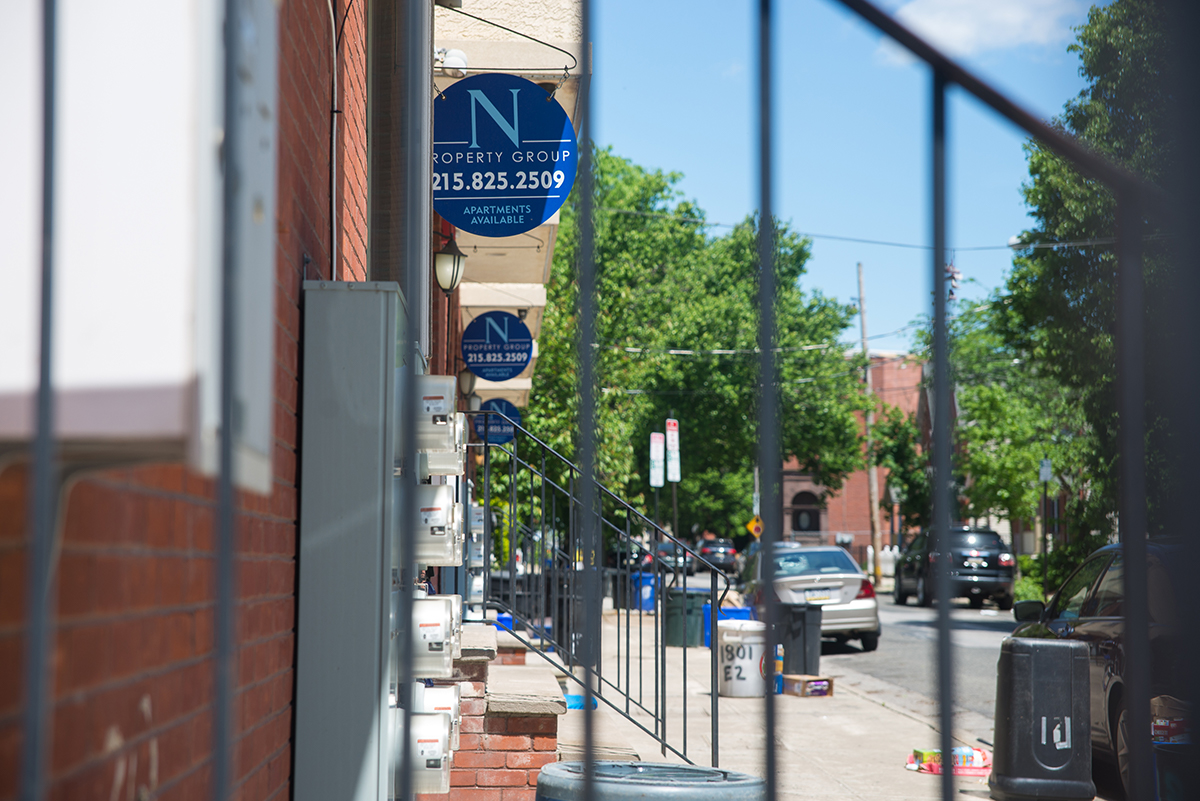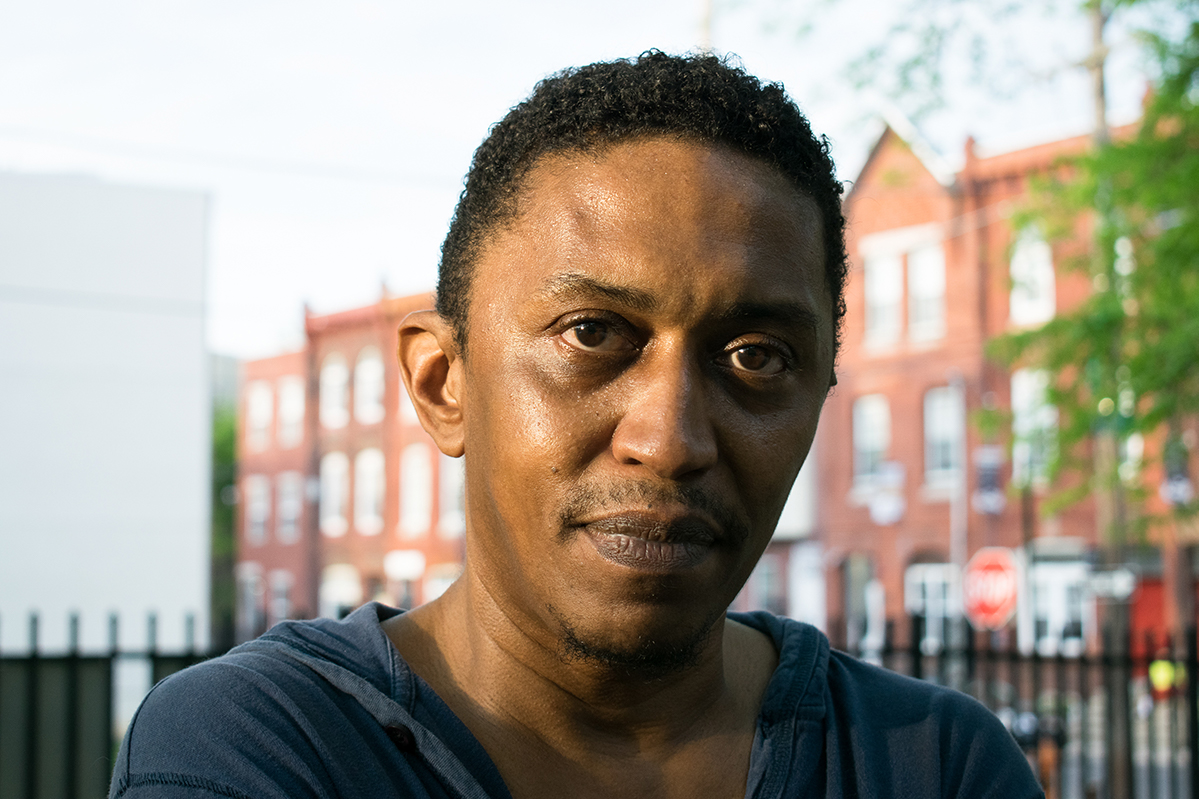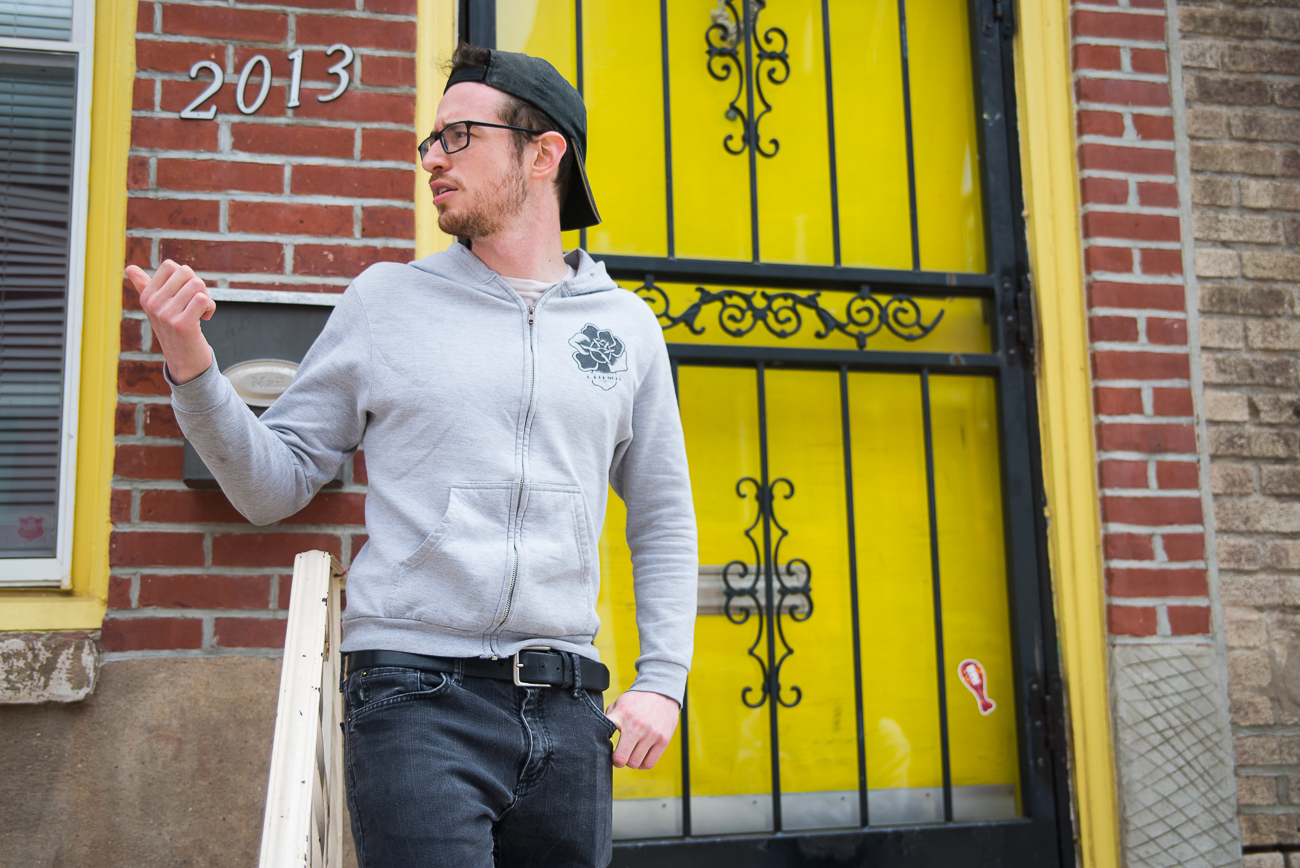Hold onto your house, if you can. It’ll be worth a lot of money some day.
This is the advice Alexis Savage’s grandmother left her decades ago. Savage, 67, still lives in her aunt’s home with her daughter and grandson. Her cousins used to live a few houses down from their home on Fontain Street near 16th. Her late grandmother lived across the street.
Savage has watched her community — and property value — change drastically since her family moved into the home in the early 1950s. In one year, her home’s market value increased from $103,700 in 2018 to $204,500 in 2019 due to property improvements and increased property value.
“…I’ve lost a lot of friends because they have moved from the neighborhood,” Savage said.
“Only a few of us are still left here ‘cause you had to have your house in order, financially, to stay around here,” she added, as her grandson played with his toy water gun on her home’s stoop. She looked up and down her street and reminisced on what her community looked like before developers moved in.

Nearly 15 years ago, the late Temple University President David Adamany predicted this. Residents who own their homes could sell them for a “premium” if there was a strong off-campus student housing market, he said in a 2005 interview with The Temple News.
At the time, Temple was transitioning from a commuter school to an on-campus living one. Temple was in the business of education, not housing, he said four years after opening 1300 Residence Hall.
This was Temple’s standard for the next several years: take its hands off on-campus housing to avoid a risky financial investment and instead let the student housing market develop on its own. Temple did not build another on-campus housing option until Morgan Hall opened at Broad Street and Cecil B. Moore Avenue in 2013 with 1,275 beds.
Now, developers from across the country have purchased properties around Temple to cash in on the booming market. Most developers live in Pennsylvania, according to data analyzed by The Temple News, but property owners from 37 states own homes near Main Campus, not including two owned by people in Puerto Rico and one in Toronto. Other top property owners live in New Jersey, New York, Delaware, Florida and California.
With a soaring off-campus housing market and an estimated 6,000 students looking to lease off campus each year, a host of problems are arising for community residents and students. Near Temple, people are paying a median $765 in rent and utilities, according to the 2017 American Community Survey 5-year estimate. Sometimes, students never meet their landlords who could live hundreds of miles away, which can lead to little to no oversight of their properties and ever-increasing rent.
This created a breeding ground for problems like trash and partying, which affect community residents’ quality of life. The style of each property varies from door to door, some with boxy, modular facades and others still left with an original brick rowhome look. But no matter whether landlords live on site or in California, the neighborhood won’t ever look the same, and residents are bracing for their community and livelihoods.
BOOMING PROPERTY VALUES
It’s clear that properties around Temple are in high demand.
In ZIP codes 19121 and 19122, which encompass Temple’s Main Campus, nearly 3,600 properties have been purchased since 2010. Only 58 properties were bought in 2000. More than 15 years later, in 2017, 720 were purchased. The prices at which people are buying these properties are growing at a similar rate, with the average buying price in 2017 at more than $306,000. In 2000, that average price was closer to $34,003 when adjusted for inflation.
Investors all over the United States are seizing the opportunity to make money off of renters around Temple — who are primarily students.
More landlords are investing in property around Temple because they are always looking to get involved in a place that’s “hot,” said David Wilk, Temple’s real estate management program director.
Universities like Temple fuel this by driving economic development, innovation and entrepreneurship, Wilk said.
Every city has its fair share of both good and bad landlords, he added. Some landlords are in it just for the money.
“They just milk it,” Wilk said. “They milk it for every dollar that they can and usually an absentee landlord, or someone who doesn’t effectively manage his property, is going to be much more noticeable than one who really cares about their properties.”
While these absentee “slum landlords” vex city officials and local residents, Wilk added, they can still make money by not managing their properties well.
Still, Temple is a great place to invest right now, because of its increasing student population, he said.
CITY AND UNIVERSITY PLANNING
In Temple’s 2014 Visualize Temple campus master plan, administrators outlined several long-term on-campus housing plans. These include adding residence halls behind Temple Towers and next to White Hall, redeveloping Johnson & Hardwick halls and replacing Peabody Hall, which was demolished last year. As the student body continues to grow, more students will be looking for places to live on and near Main Campus.
But there are no plans to do so within the next year. That leans on city officials to ensure off-campus development is done right.
Off-campus developers need to receive city approval before tearing into any property, according to city property laws.
There are some areas, like on Diamond Street, that have historic designations that require review from the Philadelphia Historical Commission before any exterior changes are made to a building, a spokesperson for the City Planning Commission wrote in an email.
When a property owner wishes to change their property — whether they want to change its facade, add an addition or completely convert the space — it almost always needs to go through a community approval process in its local ward.
Developers or a representative must describe their intended project at a public community meeting. Votes by the ward, a registered community organization within the city, are nonbinding. The Department of City Planning takes the community’s opinion into account if it is concerned with zoning issues.
Judith Robinson, the chairperson for the 32nd Democratic Ward Registered Community Organization that encompasses many off-campus properties west of Broad Street, said the decisions among community residents are rarely ever unanimous.
“There’s some people who will come to a meeting, they oppose every single development,” Robinson said.
“There’s a lot of friction,” she added. “Somewhat of an attempt to ‘protect our neighborhood.’”
After some meetings, Robinson will call people who were upset about a specific project and try and learn more details about their concerns, she said. She will then act as a liaison between the developer and the resident to try and compromise on elements of the project.
As development began to “take off” near Temple, the City Planning Commission worked with City Council President Darrell Clarke to choose areas where multi-family units would be allowed and areas that would remain dominated by single-family homes, wrote Paul Chrystie, a spokesperson for the City Planning Commission in an email to The Temple News.
The City Planning Commission does not largely have a say over what a property can look like, as a result of private property rights, Chrystie added.
Robinson said in the five years she’s led the 32nd Ward, she’s seen an increase in developers approaching the Zoning Board of Adjustment for approvals to convert single-family to multi-family units, which are geared toward groups of student renters.
This is among the many changes Robinson has seen in the neighborhood, some good and some bad, she said.
Community residents can benefit from a lot of the businesses and services that move into the area to cater to Temple students, she said. But “the bad,” includes her neighbors dealing with issues like student behavior problems, noise, trash and parking.
DEVELOPING
The Temple News called 15 property owners near Main Campus and attempted to track down contact information for many others online.
Joyce Jeter, a 1975 psychology alumna, and her husband, Lawrence Jeter, own a three-unit home on Diamond Street near 25th that they currently rent to residents, not students.
They decided to buy the property in 2018, in part because Joyce Jeter anticipated the university’s expansion when she was a student at Temple, she said.
“Back then, it was said that the plan was for Temple to visually meet the University [City], Penn area,” Joyce Jeter said. “The plans were in place way long before now. That was part of the consideration when we decided to buy, because I remembered that from the 70s.”
Joyce Jeter is originally from West Philadelphia and moved with her husband about three years ago to Milton, Massachusetts, outside of Boston.
“Students are going to cause local residents to be out-priced,” Joyce Jeter said. “They’re not going to be able to afford it.”
Eventually, Joyce Jeter may have to raise rent on her own tenants, which is currently “not high,” she said. Increased competition from student housing and rising property taxes will continue pushing permanent residents out, she said.
A new multi-family unit is under construction on the corner of Willington and Oxford streets on April 14. | SAMEET MANN / THE TEMPLE NEWS
Ronald Bacon, 68, and his son Kevin Bacon manage BRK Development, which has one three-unit building two blocks from Main Campus on 16th Street near Montgomery Avenue. They bought the property in 2013 based on a recommendation from Ronald Bacon’s fraternity brother.
The father and son manage the property themselves, though they live in South Jersey. Ronald Bacon, who grew up in West and South Philadelphia, said he comes to check on the house at least once a month. Young people’s interest in living in Philadelphia has changed the city he has known over the years, he said.
“The gentrification…it’s a natural phenomenon in the city,” Ronald Bacon said.
“Therefore, the city has to, as its social responsibility, make sure there are properties available that [low-income people] can afford,” he added.
BRK Development mainly markets to students and otherwise had only one faculty tenant for a one-year lease in the past, Ronald Bacon said. Residents haven’t shown much interest in renting the property, he said.
“We are pretty particular about keeping this a student property,” he added. “…We would not discriminate [against residents], but our preference is to have students there because it does work better when you have common people in the apartment. At least it has for us.”
While BRK Development feels the impact of rising property values and “much, much higher” taxes, its student tenants have been consistent and the 16th Street property was worth the $375,000 investment, Ronald Bacon said.
“The stability of the students has helped that area pretty well,” he said. “We’ve actually been really successful in having our students stay for two or three years. We pick them up as a sophomore, and we’re only two blocks from the Main Campus and that has a lot of attractiveness in the area.”
MANAGING
Some developers and property owners, who may not be able to attend to their tenants because they don’t live nearby or are busy with other investments, hire management companies to handle the day-to-day needs of students.
MK Management Group is one of them. Connor McCarthy, a property management specialist and junior finance major, said the company manages 280 units for about 70 property owners near Main Campus. One other company, N Property Group, manages approximately 650 to 700 properties for nearly 140 property owners, an administrative assistant said. There are several others near campus, which manage the properties for a fee to the property owner.

The Temple Area Property Association, a registered community organization of developers who rent to students near Main Campus, represents property owners with a total of 3,000 to 4,000 bed spaces near the university.
TAPA has a code of conduct that emphasizes “responsible development and property management,” and “to further the common goals of safety, good conduct, and an attractive neighborhood,” according to its website.
“Most of the owners of the properties do not live in Philadelphia,” said Nicholas Pizzola, the vice president of TAPA, adding that many live in nearby suburbs. “In this Temple area, I would have to say, very few do.”
It doesn’t matter where owners live, it’s all about how they choose to manage their properties, he said.
TAPA has only removed two property developers from its membership in the past 10 years, with the last removal occurring three to four years ago, Pizzola said. The organization does not perform any oversight into the conduct of its members.
“We hold ourselves to high standards, but we can’t enforce anybody else’s ownership, because we don’t have that authority,” he said.
In the last 10 years, Pizzola said there was a high demand for off-campus housing with fewer options, so it was possible to rent a “doghouse.” Now, due to “tremendous” development, students expect their apartments to have granite countertops, ensuite bathrooms and special kitchen lighting, he said.
“It’s just gone from one extreme to the other,” he said.
“…[W]hat really matters for your experience at Temple off campus is the management provided to you by the owner, and good management trumps granite any time,” he added.
THE OFF-CAMPUS MARKET’S IMPACT ON LIFE
For Savage, her problem with development has been more about the investors who came in and showed no respect, she said. Construction for a new property often disrupts another resident’s home, like Savage’s neighbor who used to live across the street.
“When they dug so low, it cracked her foundation,” she said. “Justine was like 70 years old at that time. She had to go into a nursing home, but it wasn’t Temple ‘per se.’ It was the contractors that come out.”
Once the students move in, some problems Savage has seen are trash outside students’ houses and students who have passed out on the street from drinking, she added.
Ray Deca, 50, lives in the Diamond Park housing complex for seniors and people with disabilities on Page Street near 15th.

Deca has lived in the complex for three years. Sometimes the students with bad behavior outshine those who are good, he said.
However, some community residents felt gentrification didn’t adversely affect them and were more welcoming toward Temple students moving into the neighborhood.
“[Temple students] are people too,” said James Sumter, who lives near the corner of Page Street and 15th. “They’re human beings, and they’re trying to get a quality of life, education and everything. We all should be.”
Students themselves have noticed how much the neighborhood — and their rent — is changing during their short stays in North Philadelphia.
Alexander Fucito, a senior information science and technology major, moved into his house on Carlisle Street near Norris in August 2017 with three other roommates, but had to bring in another person in 2018 when their Miami-based landlords increased their rent by $600 to $3,000 total per month.
The increase was something “in character” for their landlords, Fucito said. Fucito and his roommates hadn’t seen much of their landlords, and it wasn’t unexpected when their rent went up, he said.
“They were very nice, a sweet older couple,” Fucito said. “They showed up over the summer. At the time, we had some bills that were overdue. …They were very nice about that.”

The owners could not be reached for comment despite multiple attempts using contact information provided by the tenants.
The property stands out with its bright yellow door and is one of the only single-family homes on the street. Its owners bought the property for $65,000 in 2004, and its 2020 market value is $186,000, according to city records.
If the university wants to help reduce rising property values and keep community residents in their homes around Main Campus, it should provide more on-campus, apartment-style housing for students, Fucito said.
On Gratz Street, which is primarily occupied by student housing managed by the area’s management groups, multi-unit home market values have surged in the past decade.
“You can notice it,” said Mike Fetterhoff, a junior finance major who lives with his three roommates on Gratz Street near Berks. “Down at the 1700 block, it’s a lot of people that used to live in Philadelphia and the places are run down, a lot of windows are busted out. And then at 1800 [block], it starts to get better.”
“There’s literally an abandoned [house] right down there, but this whole block is basically getting redone,” Fetterhoff added.
Real estate growth in this area is inevitable now, with the growth of Temple, Robinson said.
“So, at this point, we’re really just along for the ride,” she said.
HOW WE DID IT
To conduct its analysis, The Temple News used public data from the Office of Property Assessment, which was updated two months ago. The Temple News pulled all properties in the ZIP codes 19121 and 19122, which encompass Temple’s Main Campus and the surrounding North Philadelphia neighborhoods.
This data was used to calculate figures, like the most common property value, the year in which properties were purchased, how much they were purchased for and who the owners are. To find out-of-state and non-Philadelphia owners, The Temple News used properties where the owner’s mailing address did not match that of the property. Properties where the owner’s mailing address was blank were assumed to be occupied by the owner.
To calculate the median cost to renters and the number of single- and multi-unit properties, The Temple News used data from the United States Census Bureau’s American Community Survey 5-Year Estimates from 2010 through 2017. The Temple News then isolated data for 11 census tracts around Main Campus, which is a smaller geography than that which is encompassed by the Office of Property Assessment data.
To find median rental costs, the Census uses the amount an individual renter pays calculated with the estimated utility costs. More details on that calculation can be read here. To calculate the number of properties that are single- or multi-unit, The Temple News used the measurement for one-unit properties that are attached or separated. The rest, which ranged from two-unit to more than 20-unit properties, were added to create a total number of multi-unit properties.
Words and reporting by Greta Anderson, Will Bleier, Julie Christie, Gillian McGoldrick, Laura Smythe and Zari Tarazona.
Graphics and data analysis by Julie Christie.
Photos by Evan Easterling, Dylan Long, Sameet Mann and Zari Tarazona.
Web Page produced by Julie Christie.
This article was first published May 7, 2019.